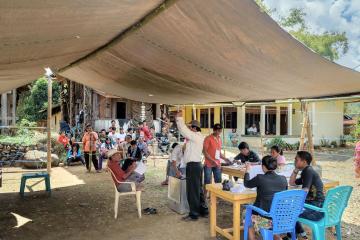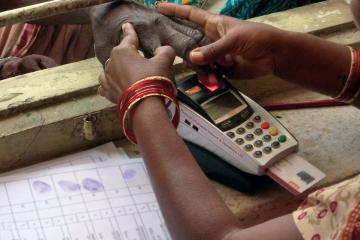Using evidence to improve open government initiatives

This post first appeared on the Open Government Indonesia blog.
The Open Government Partnership has a simple but powerful goal: for governments to truly serve and empower their citizens. To this end, each participating government partners with civil society to promote transparency, empower citizens, fight corruption, and harness new technology to improve governance.
On December 14, 2017, at the Asia Pacific Leaders’ Forum on Open Government, J-PAL Southeast Asia (SEA) co-hosted a session on achieving poverty reduction and economic development through open government. The goal of the forum was to convene leaders in government, business, civil society, and development to discuss linkages between open and responsive government and inclusive development.
J-PAL SEA Executive Director Lina Marliani shared examples from J-PAL affiliated researchers’ work to highlight how randomized evaluations can be used to inform open governance programs. At J-PAL, our network of affiliated professors specializes in this type of evaluation to answer critical questions in the fight against poverty. The main purpose of using randomized evaluations is to determine whether a program has an impact, and more specifically, to quantify how large that impact is. The following examples help to illustrate how promoting transparency, citizen participation, and accountability can lead to improved service delivery and, in turn, development.
Making information transparent can improve service delivery
One way that open government initiatives can improve service delivery is through increasing transparency—for instance, by providing information about social programs and citizens’ eligibility and rights under such programs.
In Indonesia, the Raskin (Rice for the Poor) program provides 15 kg of subsidized rice each month to the country’s poorest households. Despite being Indonesia’s largest social assistance program, with a budget of over US$2 billion per year, Raskin suffers from leakages and targeting issues—rice often disappears on the way to the village or ends up in the wrong households. J-PAL affiliated researchers partnered with the National Team for the Acceleration of Poverty Reduction (TNP2K) to test a new design of the identification cards citizens use to access Raskin—printing the price and the amount of rice to which beneficiaries are entitled on the cards themselves.
Overall, the cards led to large increases in the subsidies eligible households received, likely because cards gave them more bargaining power with the local officials who distributed rice. This illustrates that even in major, long-running programs, information about citizens’ rights may be scarce. In such contexts, providing information—a very simple solution—can be a powerful tool to improve service delivery. Based on this evidence, TNP2K decided to scale up ID cards nationwide and expanded their coverage to include additional safety net programs, reaching over 65 million people.
Citizen participation in decision-making processes can improve satisfaction
In recent years, a growing number of countries have decentralized decision-making power over service delivery to local governments. Through decentralization, policymakers hope to better align new projects with community needs and preferences. However, there is concern that these processes may simply empower local elites at the expense of ordinary citizens. An alternative to having elected representatives make funding decisions is direct democracy: allowing citizens to participate directly in decision-making processes.
To examine these issues, researchers, in partnership with the Government of Indonesia, studied citizen participation in the Kecamatan Development Program (KDP), which provides grants for local infrastructure projects to approximately 15,000 villages each year. In the study, villages were assigned to choose projects either through direct voting or a representative-based community meeting. In direct voting, villagers selected among the proposed projects by voting in a local election. In the community meetings, representatives from each neighborhood of a village selected projects at local meetings.
Results indicate that citizen participation can substantially improve satisfaction with the political process and access to services. Choosing local infrastructure projects by direct voting, rather than through representatives, had a small effect on the types of projects selected but a much larger impact on citizen satisfaction. Turnout for direct voting was high at 80 percent, as was satisfaction with the projects and the selection process. Citizens in villages with elections were also more likely to know about the projects and to express willingness to contribute to them.
Technological innovations can improve accountability and reduce leakages
Each year, governments spend significant resources on social assistance programs. Yet, much of this money may not reach its intended recipients, due to corruption, mismanagement, and other forms of inefficiency. Innovations in technology can improve governance by reducing opportunities for corruption and leakages. Similar to transparency, however, political economy factors are important to consider when implementing interventions aimed at reducing corruption.
In 2006, the Government of Andhra Pradesh introduced India’s first large-scale biometrically authenticated payment system. Researchers partnered with the government to assess whether the introduction of electronic “Smartcards” reduced leakages in the delivery of two social assistance programs.
They found that introducing Smartcards reduced corruption and substantially improved the delivery of government social assistance programs. The system improved the payment process by reducing payment delays and unpredictability. Furthermore, beneficiaries of both social programs received more money, but official disbursements did not change, implying a reduction of more than 40 percent in leakages in both programs.
Across these examples, we see that providing information, encouraging citizen participation, and leveraging technology can improve transparency and accountability and, by extension, public service delivery. These are just a few examples from numerous evaluations that shed light on how evidence can inform open government initiatives across the Asia Pacific region and beyond.


